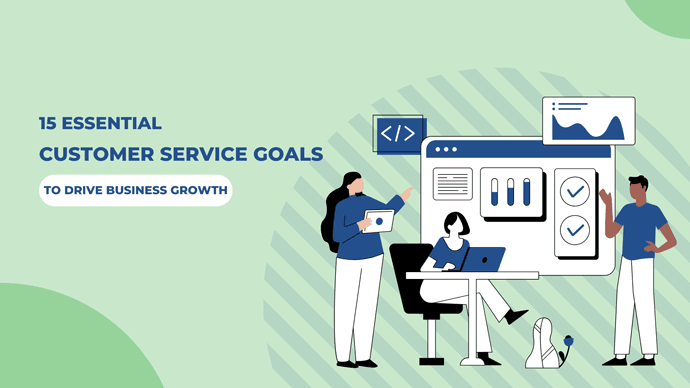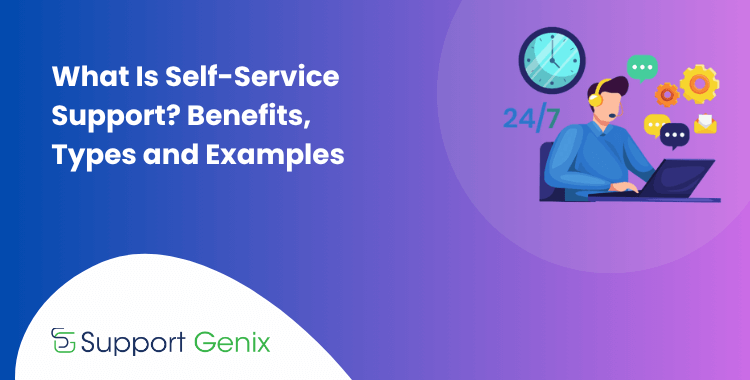15 Essential Customer Service Goals to Drive Business Growth in 2025
Customer service goals are crucial for establishing a robust online business presence in today’s market.
Strategic service objectives help organizations improve customer satisfaction and create lasting customer relationships.
Setting clear customer support goals ensures your support team delivers focused and aligned service experiences.
Well-defined customer service targets enhance team performance and create streamlined operational workflows.
According to Bain & Company, businesses with excellent customer service achieve revenue growth 4-8% above market rates.
Companies that invest in robust customer service strategies experience higher customer retention and increased brand advocacy.
Whether you’re launching a new business or managing an established company, effective service goals elevate brand reputation.
This comprehensive guide explores 15 essential customer service objectives that will transform your business operations.
We’ll show you how to implement customer-centric strategies that deliver measurable business results.
These actionable service goals will help you build competitive advantages in your market segment.
Let’s explore these proven customer service strategies that drive business success.
Key Takeaways
- Learn essential customer service goals that form the foundation of exceptional support and business growth.
- Discover how to build strong customer relationships through personalized service and proactive support strategies.
- Understand the importance of consistent service quality across all communication channels and platforms.
- Explore how to use technology, including AI and self-service tools, to enhance customer support efficiency.
- Master techniques for developing high-performing support teams through training and empowerment.
- Learn how to measure service performance and align customer support with business objectives.
Why Do You Need to Set Customer Service Goals?
Strategic customer service goals create a foundation for sustainable business growth and market leadership. Here’s why implementing service objectives is essential for your organization:
- Enhance Team Performance and Focus: Customer service goals provide clear direction for support teams to deliver exceptional customer experiences. Well-defined objectives help service representatives prioritize tasks and maintain consistent quality standards.
- Drive Customer Satisfaction: Companies that set measurable service goals achieve 35% higher customer satisfaction scores (CSAT) than competitors. Strategic service targets lead to faster response times and more personalized customer interactions.
- Accelerate Business Growth: Regular tracking of customer service metrics reveals opportunities for service improvement and business expansion. Data-driven insights help organizations optimize their support operations and enhance service delivery.
- Gain Competitive Advantage: Strong customer service standards differentiate your brand in today’s highly competitive business environment. Companies with excellent service experience have 2.4 times more revenue growth than industry averages.
- Improve Operational Efficiency: Clear customer service objectives, streamline support processes, and increase team productivity by up to 25%. Structured goals help organizations allocate resources effectively and reduce operational bottlenecks.
- Build Customer Loyalty: Organizations with strategic service goals experience 60% higher customer retention rates than competitors. Satisfied customers become brand advocates and generate valuable word-of-mouth marketing.
Recommended Blogs For You:
👉 How to Say Sorry for the Inconvenience
👉 How to Improve eCommerce Customer Experience: 10 Effective Ways to Boost Sales
👉 A Guide to Key Customer Experience KPIs: Measuring Success
👉 Best WordPress Halloween Deals in 2024 to Treat Yourself
15 Essential Customer Service Goals for Your Business

Fundamental Service Goals
These foundational goals directly impact customer satisfaction and business growth. Building strong core service practices ensures long-term success.
1. Resolve Issues First Time (First Contact Resolution)
First contact resolution directly impacts customer satisfaction and reduces support costs by up to 30%.
Support teams must have comprehensive knowledge and authority to solve problems without escalation.
Implementing proper training and decision-making frameworks helps achieve an ideal FCR rate of 80% or higher.
2. Respond Quickly and Thoughtfully
Fast response times significantly impact customer satisfaction, with 60% of customers expecting responses within 10 minutes.
Support teams should maintain average response times under 5 minutes for chat and 1 hour for email communications.
Implementing automated acknowledgments and queue management systems helps maintain consistent response times during peak periods.
3. Listen to Feedback and Act On It
Customer feedback provides invaluable insights for service improvement and product development opportunities.
Regular analysis of customer surveys, reviews, and support interactions helps identify recurring issues and improvement areas.
Companies that actively implement customer feedback see a 15% increase in customer satisfaction scores.
4. Track and Optimize First-Time Resolution Rates
Companies with high first-time resolution rates experience 33% higher customer satisfaction and 25% lower support costs.
Support teams should maintain detailed interaction logs and analyze common escalation patterns to improve resolution rates.
Implementing comprehensive agent training and creating detailed solution guides helps achieve first-contact resolution targets.
Customer Experience Enhancement
Creating exceptional customer experiences differentiates your brand and builds lasting relationships. These goals focus on personalized interactions that drive customer loyalty.
5. Make Every Interaction Personal
Personalized customer service increases customer satisfaction rates by up to 40% compared to generic responses.
Support teams should use customer history, preferences, and behavior data to tailor their communication approach.
Implementing CRM systems helps track customer interactions and deliver consistent personalized experiences.
6. Build Loyalty Through Genuine Care
Customer retention costs 5-25 times less than acquiring new customers through marketing efforts.
Support teams should focus on creating emotional connections through empathetic communication and proactive problem-solving.
Implementing loyalty programs and personalized follow-ups helps maintain long-term customer relationships.
Operational Excellence
Streamlining operations and maintaining consistent service quality across all channels maximizes efficiency.
These goals help optimize your support processes and resource utilization.
7. Be Consistent Across Every Platform
Omnichannel support consistency increases customer satisfaction by 25% across all interaction points.
Teams need standardized response templates and unified customer data across email, chat, phone, and social media channels.
Regular training ensures support quality remains consistent regardless of the communication channel.
8. Enhance the Use of AI and Automation
AI-powered support tools can handle up to 70% of routine customer inquiries without human intervention.
Implementing chatbots and automated response systems reduces response times and support costs significantly.
Smart routing and predictive analytics help prioritize complex issues for human agents.
Self-Service and Proactive Support
Modern customer service extends beyond reactive support to anticipate and prevent issues. These goals empower customers while reducing support workload.
9. Empower Customers with Self-Service Tools
Self-service options reduce support tickets by 50% and improve customer satisfaction scores.
A comprehensive knowledge base, FAQs, and video tutorials help customers find answers independently.
Regular updates to self-service content based on common inquiries ensure continued effectiveness.
10. Anticipate Needs Before They Arise
Proactive support reduces customer effort scores by 40% and prevents common issues from escalating.
Analysis of customer behavior patterns helps identify potential problems before they impact customers.
Regular system health checks and automated alerts enable timely interventional support.
Team Development
A well-trained support team delivers exceptional customer service. Companies that invest in team development see 41% higher satisfaction scores.
11. Customer Support Team Training and Empowerment
Well-trained support teams achieve 28% higher customer satisfaction rates than undertrained teams.
Regular skill development programs and product knowledge updates keep teams current with best practices.
Empowered agents with decision-making authority resolve issues 35% faster than those requiring supervisor approval.
Service Quality and Growth
Quality service must scale with business growth. Companies focusing on scalable processes achieve 45% higher customer retention.
12. Improve Service Scalability
Scalable customer service infrastructure enables businesses to handle 200% more customer inquiries without compromising quality.
Support teams need robust systems and processes that can adapt to sudden spikes in customer demands.
Implementing cloud-based support solutions and flexible staffing models helps maintain service quality during business growth.
13. Enhance Emotional Intelligence in Customer Support
Support teams with high emotional intelligence achieve 27% higher customer satisfaction scores than traditional support models.
Customer service representatives must effectively recognize, understand, and respond to customer emotions during challenging interactions.
Regular emotional intelligence training and scenario-based practice sessions help teams develop stronger customer connections.
14. Measure and Track Key Performance Indicators (KPIs)
Data-driven customer service teams outperform intuition-based teams by 40% in satisfaction scores and efficiency metrics.
Essential KPIs include average response time, customer satisfaction score (CSAT), Net Promoter Score (NPS), and first contact resolution rate.
Regular KPI analysis and team performance reviews help identify improvement opportunities and optimize service delivery.
15. Align Customer Service with Business Goals
Customer service alignment with business objectives leads to 32% higher revenue growth and improved market positioning.
Support teams must understand company goals and adjust their service strategies to support broader business initiatives.
Regular collaboration between service teams and business leadership ensures consistent alignment with organizational objectives.
Support Genix
WordPress Support Ticket Plugin
Take Your Customer Support to The Next Level and Boost Customer Satisfaction Rates
Frequently Asked Questions
What tools can help track customer service goals?
Customer service platforms like Zendesk and Freshdesk track response times and resolution rates. CRM systems such as Salesforce measure customer satisfaction and track interaction histories.
Analytics tools like Google Analytics monitor website support page effectiveness. Performance dashboards help visualize KPIs and identify service improvement opportunities.
What are the most important customer service KPIs?
First Contact Resolution rate measures immediate problem-solving effectiveness at 80% benchmark.
Customer Satisfaction Score (CSAT) indicates service quality with targets above 90%. Average Response Time should stay under 5 minutes for chat support.
How can businesses improve customer service response times?
Implement AI chatbots to handle routine inquiries and provide instant responses.
Create templated responses for common customer questions to speed up reply times.
Set up automated ticket routing to direct issues to specialized support agents.
How often should customer service goals be reviewed?
Monthly reviews help teams track progress and identify immediate improvement areas.
Quarterly assessments allow strategic alignment and goal adjustments based on performance data.
Annual comprehensive reviews ensure long-term objectives match business growth and market changes.
How to train teams to achieve service goals?
Begin with comprehensive onboarding focusing on product knowledge and service standards. Schedule regular coaching sessions using real customer scenarios and feedback analysis. Provide ongoing training through microlearning modules and weekly skill development workshops.
Conclusion
Setting strategic customer service goals transforms your support operations and enhances brand reputation.
Research shows that companies with defined service goals achieve 45% higher customer satisfaction rates.
These measurable objectives provide clear direction for support teams and improve service quality.
High-performing customer service teams drive business growth through increased customer retention.
Companies implementing these 15 essential service goals report 60% higher customer lifetime value.
Start by implementing core service fundamentals, then gradually expand to advanced strategies.
Remember that customer service excellence requires continuous monitoring and adaptation.
Regular assessment of these goals helps identify improvement opportunities and maintain service quality.
Your investment in customer service today builds the foundation for sustainable business success.
Ready to elevate your customer service? Begin implementing these goals today to enhance customer satisfaction and drive business growth.



